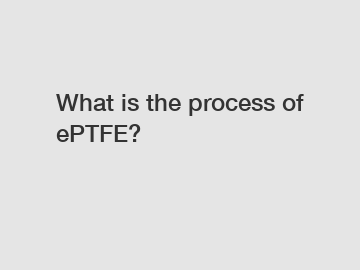What is the process of ePTFE?
What is the process of ePTFE?
ePTFE (expanded polytetrafluoroethylene) is a highly versatile material widely used in various industries, including medical, chemical, and automotive. The unique properties of ePTFE, such as excellent chemical resistance, low friction coefficient, and high-temperature stability, make it highly desirable for many applications. Understanding the process of how ePTFE is produced is crucial to appreciate its distinct characteristics and the impact it has on numerous sectors.
The process of ePTFE starts with virgin PTFE resin, which is obtained through the polymerization of tetrafluoroethylene gas. The resin is then compression molded into billets or rods. These billets are sintered to form a dense material, which serves as the starting point for ePTFE.

To create ePTFE, the dense PTFE material undergoes a unique expansion process. First, it is "cold stretched" by mechanical means or through the application of heat. This stretching causes the material to elongate and create microscopic voids within its structure. These voids are crucial as they give ePTFE its characteristic properties, such as high porosity and exceptional permeability to gases and liquids.
After the initial stretching, the stretched material is then exposed to high temperatures and pressure. This process, known as "hot expansion," further increases the number and size of the voids within the material. The combination of cold stretching and hot expansion gives ePTFE its distinctive fibril structure with interconnected pores.
The resulting ePTFE material is then subjected to a controlled "bi-axial stretching" process, where it is stretched in both the longitudinal and transverse directions. This stretching aligns the ePTFE fibrils, resulting in improved tensile strength and dimensional stability.
The expanded and stretched ePTFE is post-treated with various techniques such as calendaring, lamination, or chemical treatments to further enhance its mechanical properties. These post-treatments can modify the surface characteristics, improve its bondability, or add specific functionalities such as hydrophobicity or oleophobicity.
The process of ePTFE production is critical in defining its physical properties and performance. The controlled expansion and stretching processes impart the material with its unique combination of characteristics, including a high surface area, excellent filtration capabilities, and resistance to chemical attack. These properties make ePTFE highly suitable for a wide range of applications, including filtration membranes, gaskets, seals, and medical implants.
In conclusion, the process of ePTFE involves the expansion and stretching of dense PTFE material to create a unique fibril structure with interconnected pores. Understanding this process is key to appreciating the distinct properties of ePTFE and its extensive applications in various industries. The ability of ePTFE to withstand harsh environments, provide excellent filtration, and exhibit chemical resistance has revolutionized countless sectors, offering advanced solutions to numerous challenges.
Want more information on ptfe sheet roll, hdpe sheet for construction, 5mm ptfe sheet? Feel free to contact us.

Comments
0